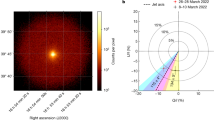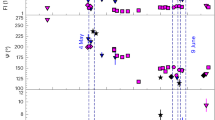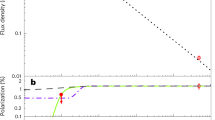Abstract
Gamma-ray bursts (GRBs) are most probably powered by collimated relativistic outflows (jets) from accreting black holes at cosmological distances. Bright afterglows are produced when the outflow collides with the ambient medium. Afterglow polarization directly probes the magnetic properties of the jet when measured minutes after the burst, and it probes the geometric properties of the jet and the ambient medium when measured hours to days after the burst1,2,3,4,5. High values of optical polarization detected minutes after the burst of GRB 120308A indicate the presence of large-scale ordered magnetic fields originating from the central engine5 (the power source of the GRB). Theoretical models predict low degrees of linear polarization and no circular polarization at late times6,7,8, when the energy in the original ejecta is quickly transferred to the ambient medium and propagates farther into the medium as a blast wave. Here we report the detection of circularly polarized light in the afterglow of GRB 121024A, measured 0.15 days after the burst. We show that the circular polarization is intrinsic to the afterglow and unlikely to be produced by dust scattering or plasma propagation effects. A possible explanation is to invoke anisotropic (rather than the commonly assumed isotropic) electron pitch-angle distributions, and we suggest that new models are required to produce the complex microphysics of realistic shocks in relativistic jets9,10,11.
This is a preview of subscription content, access via your institution
Access options
Subscribe to this journal
Receive 51 print issues and online access
$199.00 per year
only $3.90 per issue
Buy this article
- Purchase on Springer Link
- Instant access to full article PDF
Prices may be subject to local taxes which are calculated during checkout



Similar content being viewed by others
References
Piran, T. Magnetic fields in gamma-ray bursts: a short overview. AIP Conf. Proc. 784, 164–174 (2005)
Sari, R. Linear polarization and proper motion in the afterglow of beamed gamma-ray bursts. Astrophys. J. 524, L43–L46 (1999)
Ghisellini, G. & Lazzati, D. Polarization light curves and position angle variation of beamed gamma-ray bursts. Mon. Not. R. Astron. Soc. 309, L7–L11 (1999)
Rossi, E. M., Lazzati, D., Salmonson, J. D. & Ghisellini, G. The polarization of afterglow emission reveals gamma-ray bursts jet structure. Mon. Not. R. Astron. Soc. 354, 86–100 (2004)
Mundell, C. G. et al. Highly polarized light from stable ordered magnetic fields in GRB 120308A. Nature 504, 119–121 (2013)
Matsumiya, M. & Ioka, K. Circular polarization from gamma-ray burst afterglows. Astrophys. J. 595, L25–L28 (2003)
Sagiv, A., Waxman, E. & Loeb, A. Probing the magnetic field structure in gamma-ray bursts through dispersive plasma effects on the afterglow polarization. Astrophys. J. 615, 366–377 (2004)
Toma, K., Ioka, K. & Nakamura, T. Probing the efficiency of electron-proton coupling in relativistic collisionless shocks through the radio polarimetry of gamma-ray burst afterglows. Astrophys. J. 673, L123–L126 (2008)
Spitkovsky, A. Particle acceleration in relativistic collisionless shocks: Fermi process at last? Astrophys. J. 682, L5–L8 (2008)
Spitkovsky, A. On the structure of relativistic collisionless shocks in electron-ion plasmas. Astrophys. J. 673, L39–L42 (2008)
Hededal, C. B. & Nishikawa, K.-I. The influence of an ambient magnetic field on relativistic collisionless plasma shocks. Astrophys. J. 623, L89–L92 (2005)
Pudritz, R. E., Hardcastle, M. J. & Gabuzda, D. C. Magnetic fields in astrophysical jets: from launch to termination. Space Sci. Rev. 169, 27–72 (2012)
Lyutikov, M. Magnetocentrifugal launching of jets from discs around Kerr black holes. Mon. Not. R. Astron. Soc. 396, 1545–1552 (2009)
Götz, D., Laurent, P., Lebrun, F., Daigne, F. & Bosnjak, Z. Variable polarization measured in the prompt emission of GRB 041219A using IBIS on board INTEGRAL. Astrophys. J. 695, L208–L212 (2009)
Yonetoku, D. et al. Magnetic structures in gamma-ray burst jets probed by gamma-ray polarization. Astrophys. J. 758, L1–L6 (2012)
Greiner, J. et al. Evolution of the polarization of the optical afterglow of the γ-ray burst GRB 030329. Nature 426, 157–159 (2003)
Wiersema, K. et al. Detailed optical and near-infrared polarimetry, spectroscopy and broadband photometry of the afterglow of GRB 091018: polarization evolution. Mon. Not. R. Astron. Soc. 426, 2–22 (2012)
Granot, J. & Taylor, G. B. Radio flares and the magnetic field structure in gamma-ray burst outflows. Astrophys. J. 625, 263–270 (2005)
Pagani, C. et al. GRB 121024A: Swift detection of a burst with an optical counterpart. GCN Circ. 13886, (2012)
Evans, P. A. et al. Methods and results of an automatic analysis of a complete sample of Swift-XRT observations of GRBs. Mon. Not. R. Astron. Soc. 397, 1177–1201 (2009)
Sari, R., Piran, T. & Narayan, R. Spectra and lightcurves of gamma-ray burst afterglows. Astrophys. J. 497, L17–L20 (1998)
Granot, J. & Königl, A. Linear polarisation in gamma-ray bursts: the case for an ordered magnetic field. Astrophys. J. 594, L83–L87 (2003)
Hutsemékers, D., Borguet, B., Sluse, D., Cabanac, R. & Lamy, H. Optical circular polarization in quasars. Astron. Astrophys. 520, L7 (2010)
Whitney, B. A. & Wolff, M. J. Scattering and absorption by aligned grains in circumstellar environments. Astrophys. J. 574, 205–231 (2002)
Fukue, T. et al. Near-infrared circular polarimetry and correlation diagrams in the Orion Becklin-Neugebauer/Kleinman-Low region: contribution of dichroic extinction. Astrophys. J. 692, L88–L91 (2009)
Lazzati, D. et al. Intrinsic and dust-induced polarization in gamma-ray burst afterglows: the case of GRB 021004. Astron. Astrophys. 410, 823–831 (2003)
Beloborodov, A. M., Daigne, F., Mochkovitch, R. & Uhm, Z. L. Is gamma-ray burst afterglow emission intrinsically anisotropic? Mon. Not. R. Astron. Soc. 410, 2422–2427 (2011)
Lloyd-Ronning, N. M. & Petrosian, V. Interpreting the behavior of time-resolved gamma-ray burst spectra. Astrophys. J. 565, 182–194 (2002)
Kouveliotou, C. et al. NuSTAR observations of GRB 130427A establish a single component synchrotron afterglow origin for the late optical to multi-GeV emission. Astrophys. J. 779, L1 (2013)
Ghisellini, G., Tavecchio, F., Bodo, G. & Celotti, A. TeV variability in blazars: how fast can it be? Mon. Not. R. Astron. Soc. 393, L16–L20 (2009)
Barthelmy, S. D. et al. GRB 121024A: Swift-BAT refined analysis. GCN Circ. 13889, (2012)
Tanvir, N. R. et al. GRB121024A: VLT/X-shooter redshift. GCN Circ. 13890, (2012)
Patat, F. & Romaniello, M. Error analysis for dual-beam optical linear polarimetry. Publ. Astron. Soc. Pacif. 118, 146–161 (2006)
Schlegel, D. J., Finkbeiner, D. P. & Davis, M. Maps of dust infrared emission for use in estimation of reddening and cosmic microwave background radiation foregrounds. Astrophys. J. 500, 525–553 (1998)
Serkowski, K., Matheson, D. S. & Ford, V. L. Wavelength dependence of interstellar polarisation and ratio of total to selective extinction. Astrophys. J. 196, 261–290 (1975)
Bagnulo, S., Szeifert, T., Wade, G. A., Landstreet, J. D. & Mathys, G. Measuring magnetic fields of early-type stars with FORS1 at the VLT. Astron. Astrophys. 389, 191–201 (2002)
FORS Users Manual Issue 91.1 (ESO, Doc. no. VLT-MAN-ESO-13100-1543, 2012); available at http://www.eso.org/sci/facilities/paranal/instruments/fors/doc.html
Wardle, J. F. C. & Kronberg, P. P. The linear polarisation of quasi-stellar radio sources at 3.71 and 11.1 centimeters. Astrophys. J. 194, 249–255 (1974)
Simmons, J. F. L. & Stewart, B. G. Point and interval estimation of the true unbiased degree of linear polarisation in the presence of low signal-to-noise ratios. Astron. Astrophys. 142, 100–106 (1985)
Martin, P. G. Interstellar circular polarisation. Mon. Not. R. Astron. Soc. 159, 179–190 (1972)
Klose, S. et al. Prospects for multiwavelength polarisation observations of GRB afterglows and the case GRB 030329. Astron. Astrophys. 420, 899–903 (2004)
Greiner, J. et al. GROND — a 7-channel imager. Publ. Astron. Soc. Pacif. 120, 405–424 (2008)
Hjorth, J. et al. The optically unbiased gamma-ray burst host (TOUGH) survey. I. Survey design and catalogs. Astrophys. J. 756, 187–202 (2012)
Pei, Y. C. Interstellar dust from the Milky Way to the Magellanic Clouds. Astrophys. J. 395, 130–139 (1992)
Melrose, D. B. Non-thermal Processes in Diffuse Magnetised Plasmas Vol. 1 (Gordon & Breach, 1980)
Acknowledgements
This work is based on observations made with ESO telescopes at the Paranal Observatory under programme 090.D-0789. We thank all ING staff for their support of ACAM ToO observations. K.W. thanks J. Hinton for discussions. K.W. was supported by STFC. K.T. was supported by a JSPS Research Fellowship for Young Scientists no. 231446. A.J.v.d.H., R.A.M.J.W. and A.R. were supported by the European Research Council via Advanced Investigator grant no. 247295. R.L.C.S. was supported by a Royal Society Fellowship. Y.F. was supported by the 973 Programme of China, under grant 2013CB837000. D.M.R. was supported by a Marie Curie Intra European Fellowship within the 7th European Community Framework Programme under contract no. IEF 274805. This work was supported by the Australian Research Council (grant DP120102393). The William Herschel telescope and its override programme are operated on the island of La Palma by the Isaac Newton Group in the Spanish Observatorio del Roque de los Muchachos of the Instituto de Astrofísica de Canarias. This work made use of data supplied by the UK Swift Science Data Centre at the University of Leicester, funded by the UK Space Agency.
Author information
Authors and Affiliations
Contributions
K.W. and S.C. jointly led the VLT observing time proposals and defined the observing strategy. K.W. acquired, reduced and analysed the VLT data and took primary responsibility for writing the text of the paper; S.C. performed an independent data analysis. K.T., A.J.v.d.H. and M.M. provided the theoretical interpretation of the observations. K.V. and J.G. analysed the GROND data. O.E.H. led the WHT observing time proposal. All authors contributed to refining the text of the paper, or assisted in obtaining parts of the presented data set.
Corresponding author
Ethics declarations
Competing interests
The authors declare no competing financial interests.
Extended data figures and tables
Extended Data Figure 1 Host galaxy and afterglow image.
Left, VLT FORS2 Rspecial-band acquisition image, with the afterglow indicated by broken lines. Right, detection of the host galaxy in the late-time WHT ACAM r-band imaging.
Extended Data Figure 2 Polarimetry mask and afterglow brightness.
A small section of a single FORS2 Rspecial-band polarimetric exposure (this is the −45° angle chip 1 frame of the cir4 set), illustrating the shape of the aperture mask and brightness of the afterglow (indicated by an arrow). Each part of the sky that falls into the open part of the rectangular mask is imaged twice, in perpendicular polarizations, the o and e beams, which is why the same objects each time appear in two non-overlapping strips.
Extended Data Figure 3 Optical and X-ray afterglow light curves.
a, Swift XRT X-ray light curve in the time span covered by GROND observations; b, the full XRT light curve. c, Full GROND light curves in all seven bands (key at top right). Overplotted in a and c is the best-fitting smoothly broken power law (Methods), with a host galaxy contribution to the optical data. Residuals of this fit are shown in d.
Extended Data Figure 4 X-ray/optical spectral energy distribution of the afterglow of GRB 121024A.
Shown is a spectral energy distribution using the seven GROND photometric bands and simultaneous Swift XRT X-ray data. The overplotted solid line is the best-fitting absorbed power law; the dashed line shows the best-fitting power law without the effects of reddening and X-ray absorption. The horizontal error bars on the optical and X-ray data show the filter throughput and spectral bin-size, respectively. Vertical error bars show 1σ uncertainties on the fluxes.
Rights and permissions
About this article
Cite this article
Wiersema, K., Covino, S., Toma, K. et al. Circular polarization in the optical afterglow of GRB 121024A. Nature 509, 201–204 (2014). https://doi.org/10.1038/nature13237
Received:
Accepted:
Published:
Issue Date:
DOI: https://doi.org/10.1038/nature13237
This article is cited by
-
Accurate calibration on optical axis of polarizer in a polarization imaging system
Optical Review (2024)
-
Simultaneous radio and optical polarimetry of GRB 191221B afterglow
Nature Astronomy (2022)
-
Gravitational field around black hole induces photonic spin–orbit interaction that twists light
Frontiers of Physics (2017)
-
Generation of the determined vectorial vortex beams by use of an achromatic axially symmetric waveplate
Optical Review (2017)
-
The unpolarized macronova associated with the gravitational wave event GW 170817
Nature Astronomy (2017)
Comments
By submitting a comment you agree to abide by our Terms and Community Guidelines. If you find something abusive or that does not comply with our terms or guidelines please flag it as inappropriate.



